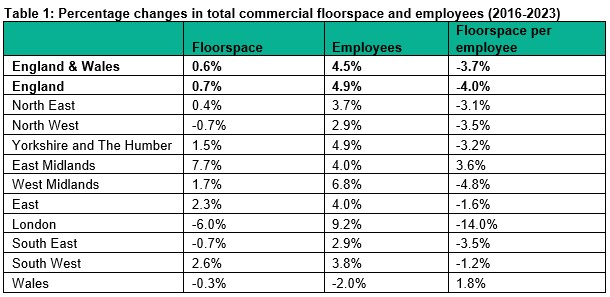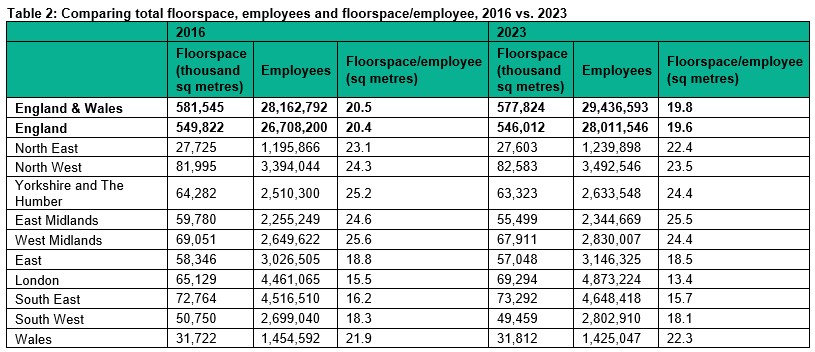 By Legal Futures Associate Search Acumen
By Legal Futures Associate Search Acumen
- Across all of England and Wales, the size of the workforce has grown seven times faster than the available commercial floorspace (4.5% vs. 0.6%).
- As a result, the average floorspace per employee has dropped by nearly 4%
- London is home to the workers who are most squeezed for space, with a growing workforce and shrinking commercial footprint seeing the average space per worker fall 14% since 2016
- East Midlands is the only region where the growth rate of commercial floorspace has exceeded the growth of the regional workforce.
The size of the workforce across England and Wales has grown seven times faster than the total volume of commercial floorspace since 2016, according to a new study by commercial property data provider, Search Acumen.
Despite some occupations shifting to hybrid working following the pandemic, the analysis shows businesses across England or Wales collectively own or rent an extra 3.72m square metres of floorspace now compared with 2016: an increase of 0.6% to 581.5m square metres.
However, Search Acumen’s comparison of official property valuations and labour market data shows the workforce has grown by 4.5% over the same period, equivalent to an extra 1.27m people in work.
As a result, the average floorspace per employee across England and Wales has fallen by nearly 4%, dropping from 20.5 square metres in 2016 to 19.8 square metres now [see table 1].
London is home to the workers who are most squeezed for space
Beneath the headline figures, London’s workers have been the most squeezed for workspace across England and Wales. In the seven years since 2016, total commercial floorspace in the capital has fallen by 6.0% to 65.1m square metres, a loss of 4.2m square metres of business space.
At the same time, the capital’s workforce has grown by 9.2% with 412,159 more people employed by London businesses now than in 2016.
The opposing trends mean the average commercial floorspace per employee in London has dropped by 14% – more than three times the national average – from 15.5 square metres in 2016 to 13.4 square metres in 2023.
Search Acumen’s analysis shows that the regional workforce has grown in every English region in the last seven years, with only Wales recording a drop in the number of employees (-2%).However, along with Wales, three regions – London, the South East and North West – have seen their commercial footprint shrink despite total employee numbers rising.
The East Midlands is the only area where the growth rate of commercial floorspace has exceeded the growth of the regional workforce since 2016 (7.7% vs. 4.0%). It also stands out as the region that has gained the most commercial floorspace overall. This has been influenced by developers’ investment in logistics and industrial, with Savills recently noting a 164% increase in annual supply equating to 5.37 million square feet in a single year. This is reflected in Search Acumen’s analysis, in which the East Midlands recorded the highest industrial floorspace growth since 2016 at 11%, compared to London which saw an -8% decline.
Andy Sommerville, Director of Search Acumen, explains:
“Forget the residential race for space; the squeeze on workspace is impacting employees across the country. Our work environments are shrinking, and so are our homes as many use spare rooms and living room nooks for full-time office work. Space continues to be a premium asset both to work in and to live.
“Although the trend in hybrid working post-pandemic has positively converted into new flexible working legislation for many occupations, home technology and regional infrastructure will now need to work harder to keep up with shifting needs.
“The East Midlands is the underdog in our data, as a region thriving from regional industrial development. Demand from retailers in this space has increased thanks to e-commerce, with counties like Leicestershire leading the pack. Well-placed to serve logistic needs, it saw a mammoth 26% jump in industrial floor place since 2016 alone.
“These regional nuances represent our evolving commercial markets, as we move away from office and retail anchored against our capital – where sectors saw an overall decline in the last seven years by -6% and -1% respectively – towards regional logistics, manufacturing, and warehousing industries. The rateable value within this sector has increased the most when compared to all other sectors too, by £162 million in one year.”












